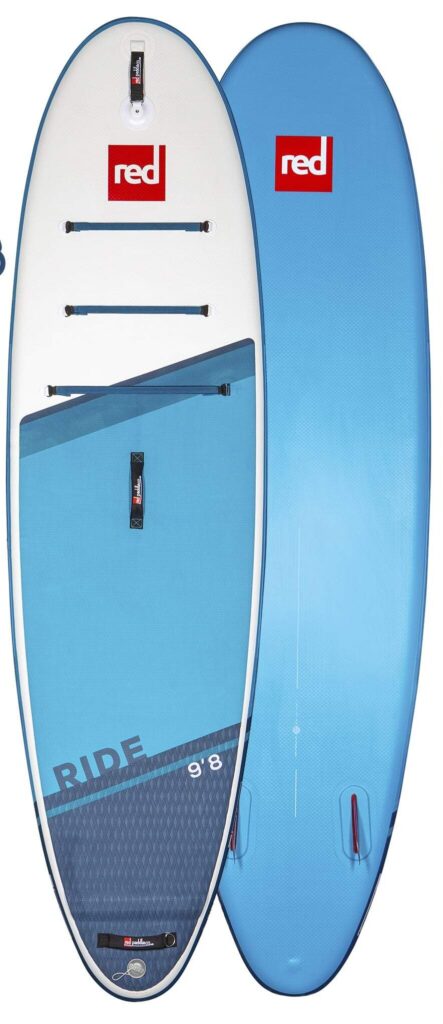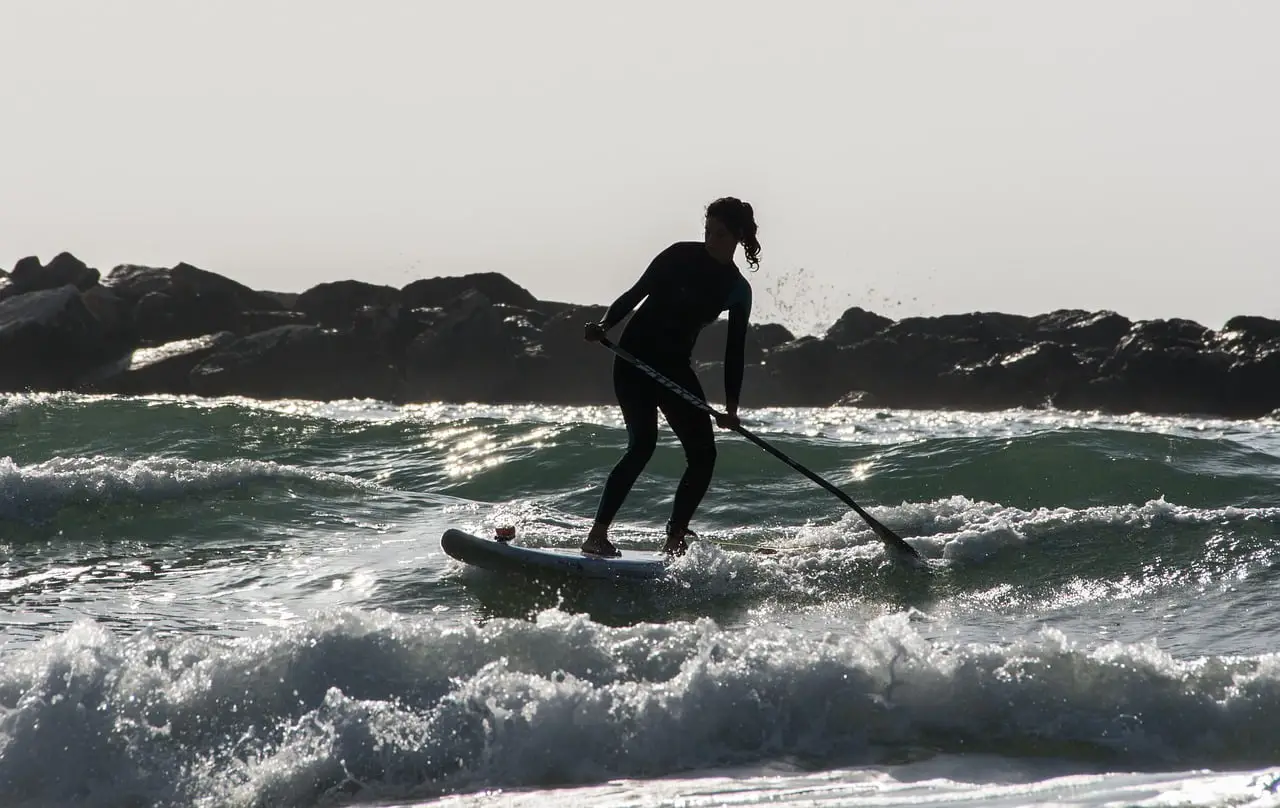If you’re looking for the origins of where stand up paddle boarding came from, Wave SUP is definitely your destination. Stand up paddle board surfing is an intense sport within the paddleboard sporting realm.
You have to really understand what a wave stand up paddle board is, how the design is crafted to enhance performance, and several other factors. All of these will be looked at closer in this article to have a full breadth of knowledge when it comes to choosing the right wave stand up paddle board.
So let’s start with the base question and answer what a wave SUP actually is and take a look at all the other information you need to know!
What Is A Wave SUP Board?
A wave stand up paddle board is usually designed with a shorter body making it a more maneuverable option. This also helps with the speed. The board’s bow is curved to penetrate the waves and give an even better maneuverability thanks to the tail rocker.

Of course, you can choose other options when opting to do a little stand up paddle board surfing. Besides a wave SUP board, you can also utilize a longer all-around board (with a length between 9 to10 ft) like the Red Paddle Ride 9’8.
But if you really go for SUP surfing and riding the waves is your goal and priority, you should choose a much shorter board with a length between 7’6” and maximum 9′ like the Naish Mad Dog Series.
No matter which model you use, they are designed to interact with the waves more smoothly and allow you to have optimal maneuverability to ride those waves as you’ve always dreamed of.


Are Paddle Boards and Surfboards The Same?
Paddle Boards and Surfboards are not the same, they differ in significant aspects. The main difference between the two has to do with the construction and design. When looking at a paddle board, you’re going to have more volume, and often it tends to be longer, wider, and thicker. Surfboards come in a broader range of options, and some may be very similar to paddle boards, but they are definitely not.
So let’s take a look at a few of the areas where these two types of boards differ.
Size
The most significant difference is in size. And that is precisely because each of the boards has a different purpose. With a paddle board, the rider needs to be able to lift themselves out of the water without the propulsion of a wave. This means that paddle boards must have more buoyancy, which comes from the board’s volume.
Even within paddle boards themselves, different variations will have varying thickness, and buoyancy depends on what they’re intended to do. For instance, if you’re looking at a racing board, it will be narrower and longer than other paddle boards because it needs speed as opposed to maneuverability.
Hull
There are two different types of hulls when it comes to boards for water sports. You have a planing hull and a displacement hull. Surfboards use a planing hull, whereas paddle boards do also have displacement hulls depending on their intended usage. This is because a planing hull is intended to have the board right on top of the water as opposed to moving in the water. Consequently, Wave Paddleboards do have a planing hull similar to Surfboards, whereas race or touring SUP Boards tend to have a displacement hull.
When it comes to the hull, another factor plays a part in the difference between a paddle board and a surfboard, and that is the material and the construction of the Board.
In SUP there are so-called inflatable boards, but also typical, “normal” hardboards. If you compare these two variants, hardboards still offer slightly better performance in the water. However, the quality of iSUPs is so good nowadays that their advantages outweigh them for most paddleboarders and are the better choice. As a result, inflatable SUPs are used more than hardboards these days.
With surfboards, it’s just the other way around: there, hardboards have a clear advantage and are therefore much more widespread.
BUT: The more extreme you become in SUP (whether wave, race or downwind), the more a hardboard makes sense there too!
Nose/Tail
Regarding the nose of a board, you will deal with a pointed or round design and occasionally a mixture of the two. This design feature tends to be pretty consistent between the two depending on the shape of the nose and what the board was made for.
The tail shape is also correspondingly similar, as both a surfboard and a Surf SUP are designed primarily for maneuverability.
Most paddleboards for surfing have a straight or dovetail tail. The same tail shape is also found in surfing, especially on shortboards, while longboards usually have a more rounded tail. Basically, however, the tail and bow shape are very similar between a pure Surfboard and a Wave SUP, which is not surprising since they are designed for the same purpose: cool and controlled turns.
However, be aware that especially the tail-shape can differ significantly between Surfboards and other types of Paddle Boards like Race SUP or Downwind.
Is An Inflatable Board Feasible For This Type of Paddle Boarding?
So if you wanted to enjoy a little stand up paddle board surfing, could you perhaps use an inflatable wave board?
There are models of paddle boards for surfing that are crafted to be inflated for more accessible transport. So yes, an inflatable SUP wave board is feasible to use, especially when you’re just starting out or do not aim for riding the biggest waves.
They tend to be more durable, very portable, and offer some advantages in weight and versatility. On the other hand, using a wave SUP board for surfing of bigger waves, you should go with a hardboard because it will offer other important technical features that could improve your performance.
Who Is a Wave Stand Up Paddle Board For?
Though anyone who will attempt to do a little paddle board surfing can really benefit from investing in a high-quality wave stand-up paddle board, there may be a couple of people who will receive just a little bit more out of it.
That, of course, pertains to those looking to really dive deep into this type of paddle boarding. By investing in a customized board designed explicitly for waves, you will have a better handling capability as well as maneuverability.
Of course, there are a ton of different options within the paddle board division. So if you’re someone who is looking to ride smaller waves, you could definitely go with an inflatable SUP Board between 9′ to 10′ length. On the other hand, if you like to do cool tricks, you might also look into the fish shape and hardboard variety of wave SUP boards as they give you more speed and maneuverability for incredible surfing capability.
What Else To Consider When Choosing A Wave Sup?
There are many other things to consider when choosing a wave SUP board. From the construction to the type of hull, all of these aspects are important to ensure that you’re getting the most from your investment. Along with this, you pay attention to the board size, and then, of course, there’s the budget.
But another factor that you want to look into is the SUP accessories you can utilize to optimize your performance. One of these just so happens to be paddles, of which there are a wide variety of excellent options. For example, if you’re looking for a top-quality option, you could always go with the Woowave Carbon SUP paddle.
Choosing the right paddle can affect your overall performance and stability upon the board when you’re investing your time in this sport. There are multiple different styles, and once again, just like with the board, you’re going to choose the one that works for your environment and style of boarding.
Final Thoughts
There are a wide variety of options when you’re looking at a wave SUP board. Though you can occasionally utilize an all-around stand up paddle board with smaller waves, it is always best to look for a SUP board designed explicitly for paddle board surfing.
This is because they are specifically designed to handle the waves and improve handling skills even when dealing with a more significant wave. There are shorter or longer versions of these boards, and each of them come with their own distinct advantages.
In the end, the choice is up to you of which wave SUP board you’re going to use because it has to correlate with your style and your waves.






